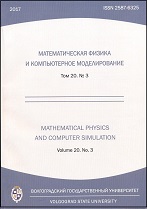|
Computer modelling
The permeability of two-dimentional porous medium of square fibers (cell model)
E. V. Mosina, I. V. Chernyshev
Volgograd State University
Abstract:
In the present study we have solved numerically the problem of a creeping two-dimensional viscous incompressible flow through a fibrous porous medium. The medium is modeled by a system of square fibers (rods) arranged across the flow. The viscous flow around the fibers is solved under the Stokes approximation using the cell model. The Happel boundary conditions (zero normal velocity and tangential shear stresses) have been posted on the boundary of the fluid cell. The numerical realization is based on finite differences of the second order accuracy with successive over-relaxation method for solving a system of linear equations.
For regular lattice of square cylinders the hydrodynamic microscopic velocity fields were determined also by the direct numerical simulations. The permeability coefficient of the model porous medium is evaluated by macroscopic averaging and Darcy low assumption. It was found that the cell model with the Happel boundary conditions gives higher values of permeability in comparison with direct numerical calculations.
A comparison between these results obtained by cell model and other direct numerical calculations, empirical and analytical relationships in a wide range of the solid concentration $\phi$ made it possible to make the following inferences.
The permeability of a rarefied system of square cylinders can be described by an explicit expression that was obtained for circular cylinders [11] but with form factor $\sigma^2$ that reflects the difference between the square and circular cross sections of the rods
$$\frac{k}{a^2}=\frac{1}{\sigma^2}\frac{1}{8\phi}\left(\ln\frac{1}{\phi}-1.476+2\phi\right),\quad
\phi\leq 0.2.$$
For moderately rarefied porous media the semi-empirical Kozeny — Carman formula is appropriate. In this case corrective factor $1/\sigma^2$ gives error of the permeability more than 25 %. To decrease the disagreement of the numerical values with the Kozeny — Carman formula this relation is better to use with the factor 8/9. The specified expression for permeability is
$$\frac{k}{a^2}=\frac{1}{9\phi}\left(\ln\frac{1}{\phi}-\frac{1-\phi^2}{1+\phi^2}\right),\quad
0.1<\phi<0.6.$$
At higher fiber volume fraction the Kozeny coefficient is $c_k=6.0$, which corresponds to a large number of experimental data on the real porous beds consisting of particles of various forms [7]
$$\frac{k}{a^2}=\frac{(1-\phi)^3}{24\phi^2},\quad 0.6\leqslant \phi<0.8.$$
These formulas are good approximations for the permeability coefficient for the system of square rods. Obtained relations for the permeability can be useful in the solutions of the macroscopic filtration problems with fibrous porous media.
Keywords:
model porous medium, square fibers, Stokes approximation, Happel cell model, permeability.
Citation:
E. V. Mosina, I. V. Chernyshev, “The permeability of two-dimentional porous medium of square fibers (cell model)”, Vestnik Volgogradskogo gosudarstvennogo universiteta. Seriya 1. Mathematica. Physica, 2017, no. 2(39), 56–64
Linking options:
https://www.mathnet.ru/eng/vvgum172 https://www.mathnet.ru/eng/vvgum/y2017/i2/p56
|

| Statistics & downloads: |
| Abstract page: | 124 | | Full-text PDF : | 56 | | References: | 44 |
|




 Contact us:
Contact us: Terms of Use
Terms of Use
 Registration to the website
Registration to the website Logotypes
Logotypes








 Citation in format
Citation in format 